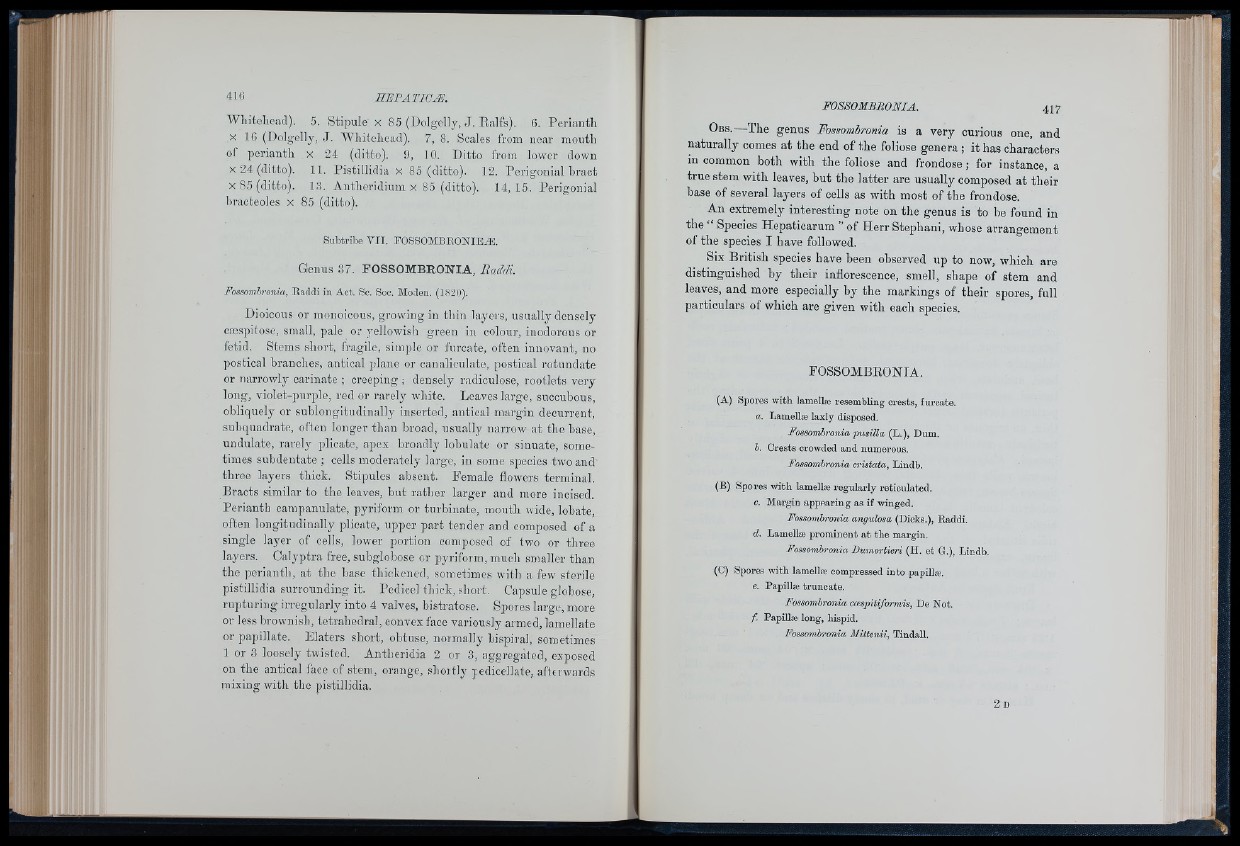
Whitelipud), 5. Stipule'X 85 (Dolg-elly, J. Ralfs). G. Periantli
x 16 (Dolgelly, J. Whitehead). 7, 8. Scales from near mouth
of perianth x 24 (ditto). 9, 10. Ditto from lower down
X 24 (ditto). 11. Pistillidia x 85 (ditto). 12. Perigonial braot
X 85 (ditto). 1,8. Antheridium X 85 (ditto). 1 4 ,1 5 . Perigonial
hraoteoles x 85 (ditto).
Subtribe V I I . FOSSOMBEONIEÆ,
Genus 37. FOSSOMBRONIA, Raddi.
Fossomhronia, Raddi in Act. Sc, Soo. Moden. (1820).
Dioicous or monoicous, growing in thin layers, usually densely
cæspitose, small, pale or yellowish green in colour, inodorous or
fetid. Stems short, fragile, simple or furcate, often innovant, no
postical branches, antical plane or canaliculate, postical rotundate
or narrowly carinate ; creeping ; densely radiculose, rootlets very
long, violet-purple, red or rarely wliite. Leaves large, succubous,
obliquely or sublongitudinally inserted, antical margin decurrent,
suhquadrate, often longer than broad, usually narrow at the base,
undulate, rarely plicate, apex broadly lobulate or sinuate, sometimes
subdentate ; cells moderately large, in some species two and
three layers thick. Stipules absent. Female flowers terminal.
Braots similar to the leaves, but rather larger and more incised.
Perianth campanulate, pyriform or turbinate, moutii wide, lobate,
often longitudinally plicate, upper part tender and composed of a
single layer of cells, lower portion composed of two or three
layers. Calyptra free, subglobose or pyriform, much smaller than
the perianth, at the base thickened, sometimes with a few sterile
pistillidia surrounding it. Pedicel thick, short. Capsule globose,
rupturing irregulariy into 4 valves, bistratose. Spores large, more
or less hrownisli, tetrahedral, convex face variously armed, lamellate
or papillate. Elaters short, obtuse, normally bispiral, sometimes
1 or 3 loosely twisted. Antiieridia 2 or 3, aggregated, exposed
on the antical face of stem, orange, slioitly pedicellate, afterwards
mixing with tlie pistillidia.
O b s .— The genus Fossomhronia is a very curious one, and
naturally comes at the end of the foliose genera ; it has characters
in common both with the foliose and frondose ; for instance, a
true stem with leaves, but the latter are usually composed at their
base of several layers of cells as with most of the frondose.
An extremely interesting note on the genus is to be found in
the “ Species Hepaticarum ” of Herr Stephani, whose arrangement
of the species I have followed.
Six British species have been observed up to now, which are
distinguished by their inflorescence, smell, shape of stem and
leaves, and more especially by the markings of their spores, full
particulars of which are given with each species.
FOSSOMBBONIA.
(A) Spores with lamellæ resembling crests, furcate.
а. Lamellæ laxly disposed.
Fossomhronia pusilla (L.), Dum.
h. Crests crowded and numerous.
Fossomhronia cHstata, Lindb.
(B) Spores with lamellæ regularly reticulated.
c. Margin appearing as if winged.
Fossomhronia angulosa (Dicks.), Raddi.
d. Lamellæ prominent a t th e margin.
Fossomhronia BumortieH (H. e t G.), Lindb.
(C) Spores with lamellæ compressed in to papillæ.
б. Papillæ truncate.
Fossomhronia coespitiformis, De Not.
f. Papillæ long, hispid.
Fossomhronia Mittenii, Tindall.
2 d